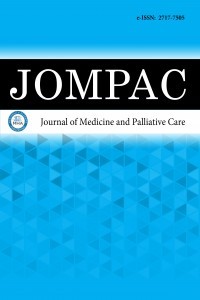1.
Obesity and overweight. WHO. Access date: 09.12.24 Available from: https://www.who.int/news-room/fact-sheets/detail/obesity-and-overweight.
2.
Body-mass index (BMI). WHO. Access date: 09.12.24, Available from: https://www.who.int/data/gho/data/themes/topics/topic-details/GHO/body-mass-index
3.
Tsur AM, Twig G. The actual burden of obesity—accounting for multimorbidity. Lancet Diabetes Endocrinol. 2022;10(4):233-234. doi:10. 1016/S2213-8587(22)00073-0
4.
Tanrıverdi S, Altun Köroğlu Ö, Kültürsay N, Egemen A. Annelerin anne sütünü arttıran faktörlere ilişkin görüş ve yaklaşımları. J Pediatr Res. 2014;1(2):84-86. doi:10.4274/jpr.87597
5.
Altunoğlu E, Ülgen E, Müderrisoğlu C, Erdenen F, Boz M. Obezite ve tiroid fonksiyonları. İstanbul Tıp Dergisi-Istanbul Med J. 2011;12(2):69-71. doi:10.5505/1304.8503.2011.88597
6.
Küçük H, Dilsiz G, Demircan N, Aktunç E, Demir Akça A, Köktürk F. B 12 vitamin düzeyi eksikliği olan hastalarla normal olan hastaların kardiyovasküler risk faktörleri açısından retrospektif olarak değerlendirmesi. Zonguldak Karaelmas Üniversitesi Tıp Fakültesi Dergisi Medi ForuM. 2015;2(1):1-11.
7.
Kayıkçıoğlu M, Tokgözoğlu L, Kılıçkap M, et al. Türkiye’de dislipidemi sıklığı ve lipit verileri: kardiyovasküler risk faktörlerine yönelik epidemiyolojik çalışmaların sistematik derleme ve meta-analizi. Türk Kardiyoloji Derneği Arşivi. 2018;46(7):56-574. doi:10.5543/tkda.2018. 23450
8.
Vlassoff C. Gender differences in determinants and consequences of health and illness. J Health Popul Nutr. 2007;25(1):47-61.
9.
Thompson AE, Anisimowicz Y, Miedema B, Hogg W, Wodchis WP, Aubrey-Bassler K. The influence of gender and other patient characteristics on health care-seeking behaviour: a QUALICOPC study. BMC Fam Pract. 2016;17(1):38. doi:10.1186/s12875-016-0440-0
10.
TÜİK Kurumsal.Türkiye Sağlık Araştırması, 2019. Access date: 12.12.24 Available from: https://data.tuik.gov.tr/Bulten/Index?p=Turkiye-Saglik-Arastirmasi-2019-33661.
11.
World Obesity Federation, World Obesity Atlas 2022. Access date: 12.12.24, Available from: https://www.worldobesity.org/resources/resource-library/world-obesity-atlas-2022.
12.
Temur HB. Sedanter kadınlarda kan basıncı ve dinlenik nabız değerlerinin bazı antropometrik özelliklerle ilişkisinin incelenmesi. Gümüşhane Üniv Sağ Bil Derg. 2023;12(4):2051-2058. doi:10.37989/gumussagbil.1321354
13.
Mendeş B, Mendeş E. Erişkinlerde kan basıncı ile vücut kütle indeksi ilişkisi. Gaziantep Üniv Spor Bil Derg. 2018;3(4):87-93. doi:10.31680/gaunjss.477951
14.
Özenmiş N. Obez hastalarda vücut kitle indeksi ile açlık kan şekeri, HOMA-IR, trigliserid, HDL düzeyleri arasındaki ilişki. Gaziantep Üniversitesi, Fen Bilimleri Enstitüsü, Biyoloji Ana Bilim Dalı Yüksek Lisans Tezi. Gaziantep, 2023.
15.
Demirbaş AB, Kılıçaslan A, Altınsöz S, Aksakal HB, Alphan ME. Üniversite öğrencilerinde sağlikli beslenme tutumu, rastgele alinan kan şekeri ve antropometrik ölçümler arasindaki ilişkinin belirlenmesi. Atlas J Med. 2024;4(10):65-72. doi:10.54270/atljm.2024.54
16.
Wang Y, Liu X, Wu B, et al. Mediation effect analysis of lipoprotein levels on BMI and cardiovascular outcomes in patients with heart failure. BMC Cardiovasc Disord. 2024;24(1):553. doi:10.1186/s12872-024-04155-9
17.
Shamai L, Lurix E, Shen M, et al. Association of body mass index and lipid profiles: evaluation of a broad spectrum of body mass index patients including the morbidly obese. Obes Surg. 2011;21(1):42-47. doi: 10.1007/s11695-010-0170-7
18.
Yang T, Liu Y, Li L, et al. Correlation between the triglyceride-to-high-density lipoprotein cholesterol ratio and other unconventional lipid parameters with the risk of prediabetes and type 2 diabetes in patients with coronary heart disease: a RCSCD-TCM study in China. Cardiovasc Diabetol. 2022;21(1):93. doi:10.1186/s12933-022-01531-7
19.
Shabana, Shahid SU, Sarwar S. The abnormal lipid profile in obesity and coronary heart disease (CHD) in Pakistani subjects. Lipids Health Dis. 2020;19(1):73. doi:10.1186/s12944-020-01248-0
20.
Passos AFF, Santos AC, Coelho ASG, Cominetti C. Associations between normal-weight obesity and disturbances in the lipid profile of young adults. Arq Bras Cardiol. 2023;120(9):e20220914. doi:10.36660/abc.20220914
21.
Manji N, Boelaert K, Sheppard MC, Holder RL, Gough SC, Franklyn JA. Lack of association between serum TSH or free T4 and body-mass index in euthyroid subjects. Clin Endocrinol (Oxf). 2006;64(2):125-128. doi:10. 1111/j.1365-2265.2006.02433.x
22.
Knudsen N, Laurberg P, Rasmussen LB, et al. Small differences in thyroid function may be important for body mass index and the occurrence of obesity in the population. J Clin Endocrinol Metab. 2005;90(7):4019-24. doi:10.1210/jc.2004-2225
23.
Santos Palacios S, Llavero Valero M, Brugos-Larumbe A, Díez JJ, Guillén-Grima F, Galofré JC. Prevalence of thyroid dysfunction in a large Southern European population. Analysis of modulatory factors. The APNA study. Clin Endocrinol (Oxf). 2018;89(3):367-375. doi:10.1111/cen.13764
24.
Wang Y, Yin Q, Xu M, Ni Q, Wang W, Wang Q. BMI Modulates the effect of thyroid hormone on lipid profile in euthyroid adults. Int J Endocrinol. 2017;2017:8591986. doi:10.1155/2017/8591986
25.
Wang X, Gao X, Han Y, et al. Causal association between serum thyroid-stimulating hormone and obesity: a bidirectional Mendelian randomization study. J Clin Endocrinol Metab. 2021;106(10):e4251-e4259. doi:10.1210/clinem/dgab183
26.
Wang X, Liu H, Chen J, et al. Metabolic characteristics in obese patients complicated by mild thyroid hormone deficiency. Horm Metab Res. 2016;48(5):331-337. doi:10.1055/s-0042-105150
27.
Marzullo P, Mele C, Mai S, et al. The impact of the metabolic phenotype on thyroid function in obesity. Diabetol Metab Syndr. 2016;8(1):59. doi: 10.1186/s13098-016-0177-x
28.
Khan A, Khan WM, Ayub M, Humayun M, Haroon M. Ferritin is a marker of inflammation rather than iron deficiency in overweight and obese people. J Obes. 2016;2016:1937320. doi:10.1155/2016/1937320
29.
Kim JW, Kim DH, Roh YK, et al. Serum ferritin levels are positively associated with metabolically obese normal weight: a nationwide population-based study. Medicine (Baltimore). 2015;94(52):e2335. doi: 10.1097/MD.0000000000002335
30.
Han H, Ni P, Zhang S, et al. The association of body-mass index and weight waist adjustment index with serum ferritin in a national study of US adults. Eur J Med Res. 2023;28(1):374. doi:10.1186/s40001-023-01343-9
31.
Emam EK, El Gendy YG, Ismail DA. Relation between serum ferritin and visceral fat mass in Ain Shams medical students. Ain Shams Med J. 2021;72(3):459-464. doi:10.21608/asmj.2021.205366
32.
Ekinci F, Merder-Coşkun D, Tuncel B, Atila D, Yıldız H, Uzuner A. Relationship between obesity and thyroid function in adults. Marmara Med J. 2018;31(2):76-80. doi:10.5472/marumj.430795
33.
Demir B, Özsoy F. Alkol/madde kullanım bozukluğu olan hastalarda laboratuvar parametrelerinin karşılaştırılması. Genel Tıp Derg. 2021; 31(4):360-364. doi:10.54005/geneltip.1036575
34.
Kulu M. Alkol-madde bağımlılarının kan parametrelerinin kıyaslanması. Kıbrıs Türk Psikiyatri ve Psikol Derg. 2019;1(Özel Sayı 1): 47-49. doi:10.35365/ctjpp.19.special1.13
35.
Rubino F, Cummings DE, Eckel RH, et al. Definition and diagnostic criteria of clinical obesity. Lancet Diabetes Endocrinol. 2025:S2213-8587 (24)00316-4. doi:10.1016/S2213-8587(24)00316-4

